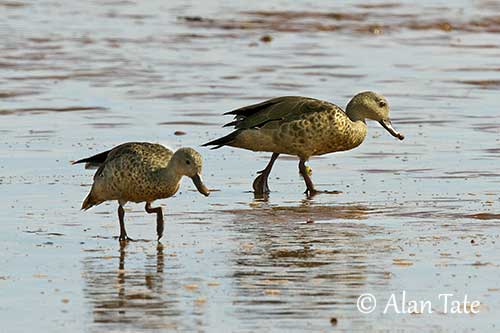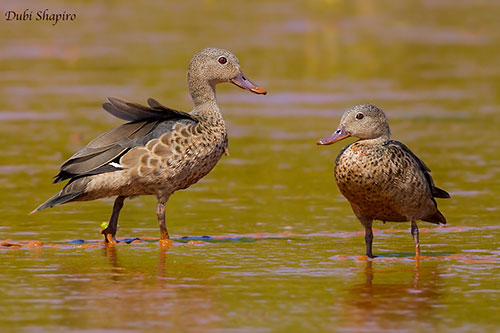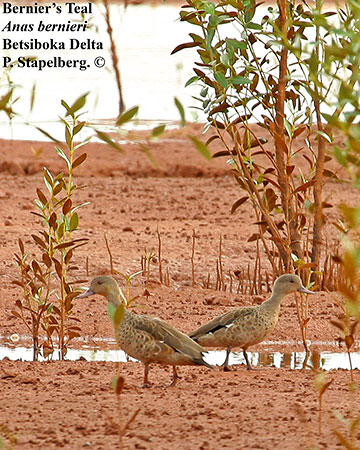
PROTECTION / THREATS / STATUS:
The Bernier’s Teal is threatened by habitat loss and disturbance throughout its breeding range, involving fragmentation of the population. Conversion of muddy water-bodies to ricefields makes the species confined to few suitable wetlands such as some inland lakes, estuaries and mudflats. Mangroves are threatened by timber extraction. Hunting pressure during the breeding season and trapping of moulting birds are major threats. Human activities involve disturbance for nesting birds.
The population is roughly estimated to number 1,000/1,700 mature individuals, and is decreasing rapidly.
The Bernier’s Teal is currently listed as Endangered.
Fr: Sarcelle de Bernier
Ang: Bernier’s Teal - Madagascar Teal
All: Bernierente
Esp: Cerceta Malgache
Ita: Alzavola di Bernier
Nd: Madagaskartaling
Sd: madagaskarkricka
Mal: Mireha
Photographers:
Dubi Shapiro
Dubi Shapiro Photo Galleries
Philip Stapelberg
GALLERY
Alan & Ann Tate
AA Bird Photography
Text by Nicole Bouglouan
Sources:
HANDBOOK OF THE BIRDS OF THE WORLD vol 1 by Josep del Hoyo-Andrew Elliot-Jordi Sargatal - Lynx Edicions - ISBN: 8487334105
GUIDE DES CANARDS, DES OIES ET DES CYGNES – de Steve Madge - Delachaux et Niestlé - ISBN: 2603013769
Birds of Madagascar and the Indian Ocean Islands Par Roger Safford, Adrian Skerrett, Frank Hawkins – ISBN: 1472924118, 9781472924117- Editeur: Bloomsbury Publishing, 2015
The Birds of Africa: Volume VIII: The Malagasy Region: Madagascar, Seychelles, Comoros, Mascarenes - Par Roger Safford, Frank Hawkins – ISBN: 1408190494, 9781408190494- Editeur: A&C Black, 2013
Birds of Madagascar: A Photographic Guide Par Pete Morris, Frank Hawkins – ISBN: 0300077556, 9780300077551- Editeur: Yale University Press, 1998
Birds of the Indian Ocean Islands Par Ian Sinclair, Olivier Langrand - ISBN: 1868729567, 9781868729562- Editeur: Struik, 2003
Wikipedia, the free encyclopaedia
Ducks, Geese and Swans: Species accounts (Cairina to Mergus) publié par Janet Kear
WAZA - World Association of Zoos and Aquariums - Madagascar teal
ASAG - Avian Scientific Advisory Group
Bernier’s Teal or Madagascar Teal
Anas bernieri
Anseriformes Order – Anatidae Family
INTRODUCTION:
The Bernier’s Teal is endemic to Madagascar. It is a small dabbling duck, found in the W coastal part of Madagascar where it frequents small, saline lakes with emergent vegetation, marshes, rivers and estuaries. This species nests in tree holes close to water or above the surface.
The Bernier’s Teal has small population and reduced range. It is threatened by habitat loss and disturbance. Competition for suitable nest holes with other species and hunting pressure involve the decline of the population, and the Bernier’s Teal is currently listed as Endangered.
DESCRIPTION OF THE BIRD:
Biometrics:
Length: 40 cm
Weight: M: 320-450 g – F: 270-420 g
The Bernier’s Teal is uniformly brown. Crown and nape are slightly darker than rest of head and neck. The upperparts are slightly “scaled” with pale yellowish-brown feather edges. On the upperwing, the wing-coverts are brown, but the greater coverts have broad white tips. The secondaries are blackish with some green gloss and white tips, forming narrow white trailing edge.
On the underparts, the brown feathers have dark centres, less distinct on flanks. The underwing is grey with white axillaries.
The bill is pale reddish to pale orange on lower mandible, and mostly greyish-pink on upper mandible with dark nail. The eyes are bright chestnut, almost reddish. Legs and webbed feet are grey-brown.
Male and female have similar plumage, but the female’s bill and legs are browner. But her bill is grey during the breeding season. The male has more vertical forehead.
The juvenile is duller and greyer overall, with more conspicuous spotting, especially on breast. The bill is grey with flesh-pink edges of upper mandible.
RANGE:
The Bernier’s Teal is found in the W coastal part of Madagascar.
HABITAT:
The Bernier’s Teal frequents the shallow waters of small, saline lakes with emergent vegetation, and wetlands including estuaries and rivers. This species nests in seasonally flooded areas and mangroves on the landward side of the coastal forest. During the dry season, it can be seen in coastal wetlands with both brackish and saline areas, and in more open habitats such as coastal mangroves, bays and estuaries. It is less frequently found in marshes, dense forest, open water and grassy savannas.
CALLS AND SONGS: SOUNDS BY XENO-CANTO
The Bernier’s Teal males gives short and quiet whistles “crik-crik-crik” fairly similar to those of Dendrocygna species. While swimming or standing, it gives loud” whee-oo”.
The female produces harsh, croaking, repeated “quack” and softer chucking notes. We can also hear a loud, repeated “criiiiik… criiiiik…”
BEHAVIOUR IN THE WILD:
The diet of the Bernier’s Teal is poorly known. From some analysis, it probably feeds on terrestrial and aquatic insects such as Hymenopterans, Coleopterans, Homopterans, Dipterans and Hemipterans. It also consumes seeds of waterside aquatic plants, and leaves and stems of monocotyledons.
It feeds by wading and dabbling while moving forwards in shallow water. It walks with the head lowered, filtering water and mud through the lamellae of the bill. It may upend in deeper water. It is mainly active in the morning and the evening.

During the breeding season, the Bernier’s Teal performs courtship displays and becomes very aggressive against congeners within small flocks. Some displays include head-pumping, head-shake, head-up-tail-up and other typical courtship behaviour of Anatidae.
They are monogamous and the pair bond is maintained across several seasons. The pair defends the area around the nest-site. The male remains close to the incubating female, and accompanies the young until they fledge.
The Bernier’s Teal is suspected to be semi-nomadic. It moves to the coast after breeding, when the lakes are drying. The post-breeding moult occurs on well-vegetated lakes.
In flight, the black-and-white wing patch is conspicuous.
REPRODUCTION OF THIS SPECIES:
The breeding season is related to the wet season on W Coast, and takes place from December to March. However, a clutch found in April suggests that the Bernier’s Teal produces two broods per season.
They nest in single pairs of loose groups. This species nests in tree holes in mangroves (Avicennia marina) close to or above water. The nest is about 2-5 metres above the ground, usually in the largest trees. It is often lined with breast-feather down.
The female lays 2-10 (6-7) pale yellow-buff eggs, and incubates during 27-28 days. The male remains close to her during this period. At hatching, the chicks have grey down above and whitish-grey below. The face is pale with narrow, dark eye stripe and small, dark ear spot. The bill is pinkish and the eyes are dark brown.
They fledge 45-49 days after hatching. They are reared by the female, but the male accompanies them until they fledge. They are fully grown at about 12 weeks, and they are sexually mature at one year old.

